TILE & STONE WORKS SHOWROOMS ARE OPEN
CLICK HERE FOR THE STERLING HEIGHTS SHOWROOM | (586) 991-5835
CLICK HERE FOR THE SHELBY TOWNSHIP SHOWROOM | (586) 254-1234
WE ARE NOW KEEPING OUR REGULAR HOURS IN THE SHOWROOMS AND WAREHOUSE
ONE ON ONE SALES AND DESIGN CONSULTATIONS
DRIVE UP LOADING
FREE LOCAL DELIVERY
586-991-5835
586-254-1234
Before You Buy - Stone Tile Countertops
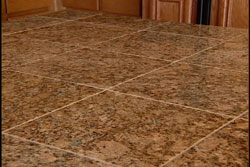

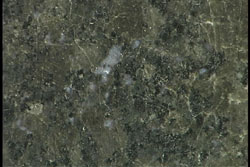
The beauty of natural stone tile adds timeless elegance to any kitchen or bath. Each tile of natural stone is different from another, making each countertop or surround a unique piece of nature's work. There are five types of stone you can choose from: marble, granite, limestone, travertine and slate. Each type varies in hardness and porosity. Your design consultant will be able to advise you on which stone types are better suited for each area you are considering depending on your needs and lifestyle.
Natural stone tiles are created from giant pieces of stone that are removed from quarries all over the world. These pieces are then cut into slabs and eventually become the tiles that will make up your countertop or surrounds. Each stone has its own characteristics. Irregular markings, shading, veining, and crystallization are considered normal and part of the beauty of the stone. The veining in your stone tiles will differ in direction from piece to piece. When each of these tiles are installed side by side on your countertop, wall or surround, the veining will not run in a consistent direction. The veining direction is dictated by the bull nose pieces of tile, the layout of the area and the tile setter. The tiles that make up your countertop or surrounds will not look exactly like the tile you saw in the design center. Additionally, if you select a combination of natural stone products, such as a stone tile backsplash or floor and the same color and type of stone slab countertop, they will not match. Also, please remember, it is not possible for you to hand select your natural stone tile.
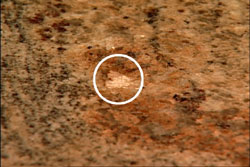
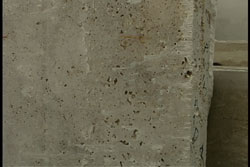
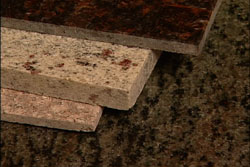
Natural stone tiles are polished or honed at the manufacturer's before installation to provide a smooth finish. Once installed there may be faint “cloudy spots” visible when viewing your countertop or wall tile from different angles and in certain lighting conditions due to swirl marks from the polishing process.
No natural stone tile will have a perfectly smooth surface. Even after the tiles are polished there may be small chips or pits that may be apparent in different lighting. Fissures, often times mistaken for cracks, are not. These markings are normal and add to the beauty of the stone.
One type of stone that has a unique polishing process is Travertine. Travertine tile uses a “fill process that creates its unique look. In its original form, travertine has thousands of holes running through it which are filled and polished after the stone is cut. The stone portion of the tile polishes to a high sheen while the filled areas remain dull. The back of the tiles are rough from the filling process. This is normal and does not affect the quality of the stone.
Being a natural product, natural stone tiles will vary more in thickness, squareness and length compared to man-made ceramic tile. As a result, once your natural stone tile is installed it will not be a completely smooth surface from tile to tile.
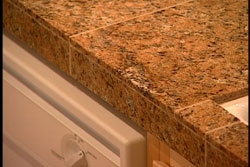
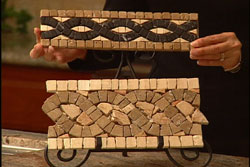
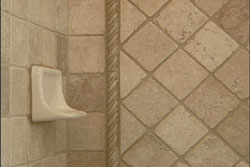
There are two types of edges that are used to complete a countertop: a bull-nose edge, which incorporates a slightly polished curved tile or a polished edge, that makes a 90 degree angle. In the bull-nose edge small chipping will occur at the edges due to the density of the stone. This is considered normal.
Natural stone liners, also called feature strips or decos, can add a customized look to your countertop or backsplash. As they are a porous natural product, grout will fill the crevices of these stone liners and will affect their color. Like ceramic liners, many pieces do vary in thickness and width and do not always have matching end pieces. In some applications, when the field tile differs in size and shape from the trim pieces, the grout lines will not align.
Once you have decided upon a tile you will then need to select a grout color. Grout can sometimes display uneven color or inconsistencies within the different areas of the same installation with the same grout color, or vary from the sample in the design center. This can be attributed to variations in temperature and humidity at the time of grouting. It is common to see slight differences in grout color when comparing the grout color in tile floor and the same color on the tile countertop or wall. Exact layouts, type of grout and grout joint widths are determined by the tile setter at the time of installation and are governed by the actual size and shape of the tile and the exact dimensions of the areas to be covered.
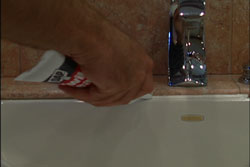
Grout may darken over time in areas with heavy water use. Check with your Design Consultant for recommendations on products specifically designed to keep your stone tile and grout looking new.
Also, please remember, it is the responsibility of the homeowner to maintain all caulked areas.
Product Information: Stone Tile

Stone Types
Granite: One of the hardest and
densest of all natural stone. Next to the diamond, it
is the hardest of the natural stones.
- Resists staining and scratching better than any
other natural stone.
- Beautiful in foyers, bathrooms, libraries or
kitchens or as an accent with other natural
stones.
- Made up of mainly quartz, feldspar and
mica.
- Mother nature produces a variety of rich colors
each with their own distinctive
characteristics.
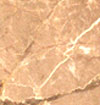
Marble: Marble is crystallized limestone that comes in many different color variations and usually displays a veining pattern that adds to its uniqueness. These veins are typically different in color from the overall color of the stone.
- A timeless addition to any home, bearing the
signs and marks of history from thousands of
years.
- More porous and softer than granite, making it
more susceptible to staining and scratching.
Therefore, marble is more suitable for bathroom
countertops/walls, shower stalls, tub surrounds or
fireplace surrounds.
- Marble is not recommended for use in kitchens.
Marble is very sensitive to acidic chemicals such as
citric acids from lemons or limes. These acids can
etch or dull a marble surface creating permanent
damage.
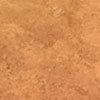
Limestone: This stone has a more
subtle look and is often offered in a “honed” or
matte finish. This stone will require preventative
maintenance over time, as it is a softer stone and
very porous.
- Created by the accumulation of organic materials
such as shells and coral.
- Colors tend to be softer and more neutral ranging
from cream, beige, brown, pale rust and soft
blue.
- Clean and simple in appearance.
- May not be suitable for all areas in the home
because it will stain easily.
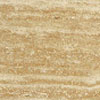
Travertine: Unique looking due to
the “fill process”. In its original form, Travertine
has thousands of holes running through it. These
holes are filled and then the stone is polished. The
stone polishes to a high sheen and the fill areas
remain dull creating a beautiful floor. Like
Limestone, this stone will require preventative
maintenance over time, due to its porosity.
- From the limestone family-so it shares some
similar characteristics such as being soft and
porous.
- Comprised of layers of mineral composites that
cool and crystallize into travertine.
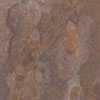
Slate: This rustic, yet elegant
stone, has become increasing popular over the years.
The beautiful color variations turn any countertop or
surround into a work of art. Slate can be used for
interiors as well as exteriors making it the perfect
product to bring the outdoors in!
- All slate has a natural clefting along the
surface which gives this stone its unique textural
look of layers.
- The most dramatic of color variations. Rich reds,
oranges and golds to black, brown and rust to mauve,
lavender, green, blue, silver and grey. Colors range
from warm and earthy to cool and sophisticated
- Extremely durable and stain resistant. Although slate does not require sealing, the grout surrounding it does. Ask your design consultant about a product that will enhance the slate and seal the grout at the same time.
- Resistant to cracking and chipping
- Beautiful for kitchen countertops and
backsplashes, bathroom countertops, backsplash and
wall surrounds and fireplaces.
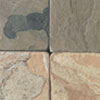
Tumbled Stone: is marble, travertine
and limestone that are tumbled and distressed to
evoke a timeworn look of stone from centuries
past.
- An old world look.
- Suitable for both the casual and formal environment.
- The perfect accent to polished granite, marble or
limestone.
- Stunning on countertops, surrounds or as
backsplash treatments.
- Available in many sizes and are often used in
borders or decorative strips. Accent strips, mosaics,
chair rails, listellos and smaller sizes such
as 1x1, 4x4, 6x6.
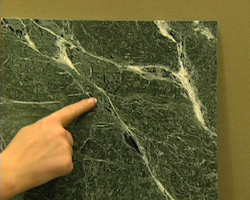
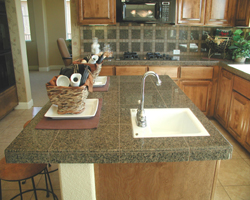
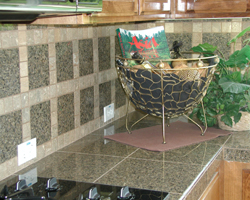
Natural Characteristics
It’s important to remember that natural stone is a
product of Mother Nature. No two pieces of natural
stone tile will look the same. Veining and
crystallization are natural characteristics of the
stone, not imperfections.
Different stones are have different levels of
hardness and porosity and are best for different
uses. Be sure to ask your design consultant about
which stone is right for the different areas in your
home depending on whether it is a wet area, like a
bath or a high traffic area such as a kitchen.
Tile Sizes
12”x12” is the size typically installed on
countertops.
Tumbled Stone is also available in smaller sizes such as 4”x4”and 8”x8” and even smaller in many of the intricate decorative borders.
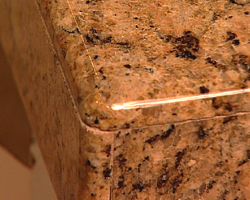

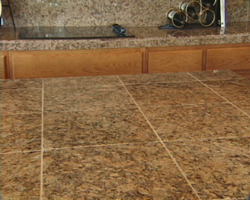
Tile Edges
There are two types of edges for natural stone
tile.
A polished bull nose edge that has a rounded or
curved appearance. A polished straight 90 degree
edge.
Natural stone tile is less expensive than natural
stone slab and still evokes an elegant look.
Selecting Grout for Natural Stone Tile
Natural Stone grout lines are typically done with
unsanded grout and are usually much thinner than
ceramic tile installations.
Design Options-grout can match, contrast or coordinate
with your stone tile. Remember, grout will outline each
tile creating a visual picture frame. If you want to
highlight the beauty of your stone and make the grout
less noticeable, select a grout that is close in color to
the stone. A contrasting grout color, either darker or
lighter, will enhance the appearance of the grout lines
creating a checkerboard effect.
Grout darkens as it ages, so sealing is recommended. Remember that grout colors can change slightly from the sample in the design center to the grout installed in your home based on the temperature and humidity when the tile is installed.
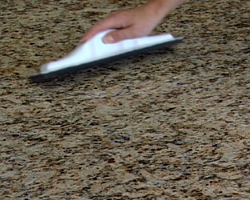
What About Sealing?
It is highly recommended that you seal your stone tile or slab after it is installed to provide additional stain resistance and to protect the stone’s original beauty. There are different types of sealers depending on the type of stone. Scratches, stains, etching and dulling of the surface are all permanent damage and forever alter the appearance of your stone. Ask your design consultant for information about sealing.
The Value of Upgrading
You will have a wider selection of types, sizes and
colors.
You will have access to more durable types of stones.
Decorative options such as accent strips, mosaics,
patterns, etc.
A timeless finish that brings value to any home.
Maintenance - Stone Tile
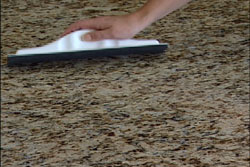
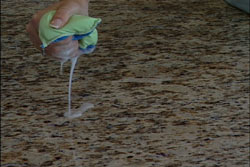

There are several different types of natural stone and each has its own level of porosity. The more porous the stone, the more easily it can stain. Therefore, the more protection you will want to help guard your investment. Depending on your lifestyle, you may want to consider sealing your stone on a regular basis. Sealing will help slow down the staining process. Manufacturers recommend sealing once every one to three years depending on the amount of usage the stone area receives. Your Design Consultant can offer you recommendations about sealing.
Manufacturers can recommend specialty products designed specifically for their stone countertops. If these are not available you can us a neutral pH detergent or pure soap, such as Liquid Ivory, for spills or periodic cleaning. Make sure to rinse thoroughly and buff dry with a clean soft cloth. Too much cleaner or soap may leave a film and cause streaks.
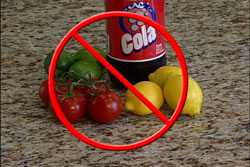
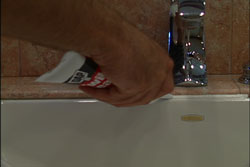
Do not use products that contain vinegar, abrasives or any ammonia-based cleaners, such as Windex. These products will dull the luster of your stone. Additionally, do not use retail grout cleaners or bathroom cleaners on your stone.
Acidic foods, such as lemons, tomatoes and soda can cause potential damage by changing the color of your stone. Also, protect your stone from oil-based products such as olive oil, cooking oil and oil-based cosmetics which can stain your countertop.
Also, please remember, it is the responsibility of the homeowner to maintain all caulked areas.
If cared for properly and routinely maintained, your new stone countertop and wall tile will bring your household lasting beauty.
